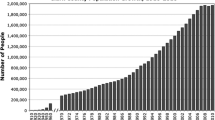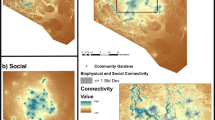Abstract
Research suggests that the formation of neighborhood social ties (NSTs) may substantially depend on the informal social contact which occurs in neighborhood common spaces, and that in inner-city neighborhoods where common spaces are often barren no-man's lands, the presence of trees and grass supports common space use and informal social contact among neighbors. We found that for 145 urban public housing residents randomly assigned to 18 architecturally identical buildings, levels of vegetation in common spaces predict both use of common spaces and NSTs; further, use of common spaces mediated the relationship between vegetation and NSTS. In addition, vegetation and NSTs were significantly related to residents' senses of safety and adjustment. These findings suggest that the use and characteristics of common spaces may play a vital role in the natural growth of community, and that improving common spaces may be an especially productive focus for community organizing efforts in inner-city neighborhoods.
Similar content being viewed by others
REFERENCES
Adams, R. E. (1992). Is happiness a home in the suburbs? The influence of urban versus suburban neighborhoods on psychological health. Journal of Community Psychology, 20, 353–372.
Altman, I. (1975). The environment and social behavior: Privacy, personal space, territory, crowding. Monterey, CA: Brooks/Cole.
Baron, R. M., & Kenny, D. A. (1986). The moderator-mediator variable distinction in social psychological research: conceptual, strategic, and statistical considerations. Journal of Personality and Social Psychology, 51, 1173–1182.
Baum, A., & Valins, S. (1979). Architectural mediation of residential density and control: Crowding and the regulation of social contact. In L. Berkowitz (Ed.), Advances in experimental social psychology (Vol. 12, pp. 131–175). New York: Academic Press.
Baum, A., Davis, G. E., & Aiello J. R. (1978). Crowding and neighborhood Mediation of urban density. Journal of Population, 1, 266–279.
Belle, D. E. (1982). The impact of poverty on social networks and supports. Marriage and Family Review, 5(4), 89–103.
Bronfenbrenner, U. (1979). The ecology of human development: Experiments by nature and design. Cambridge, MA: Harvard University Press.
Brown, B. B., & Werner, C. M. (1985). Social cohesiveness, territoriality and holiday decorations: The influence of cul-de-sacs. Environment and Behavior, 17, 539–565.
Brunson, L., Kuo, F.E., & Sullivan, W.C. (in preparation). Benefits of residents' involvement in greening: Experience from the inner city.
Buckner, J. C. (1988). The development of an instrument to measure neighborhood cohesion. American Journal of Community Psychology, 16, 771–791.
Calthorpe, P. (1991). Towns for all seasons. Architectural Record, 179, 44–45.
Campbell, D. E. & Campbell, T. A. (1988). A new look at informal communication: The role of the physical environment. Environment and Behavior, 20, 211–226.
Campbell, K. E., & Lee, B. A. (1992). Sources of personal neighbor networks: Social integration, need, or time? Social Forces, 70, 1077–1100.
Casey, C. H. (1995). Characteristics of HUD-assisted renters and their units in 1993. Washington, DC: U.S. Department of Housing and Urban Development, Office of Policy Development and Research.
Chavis, D. M., & Wandersman, A. (1990). Sense of community in the urban environment: A catalyst for participation and community development. American Journal of Community Psychology, 18, 55–81.
Chicago Housing Authority. (1995). Statistical profile: The Chicago Housing Authority 1994 to 1995. Chicago, IL: Author.
Cimprich, B. (1992). Attentional fatigue following breast cancer surgery. Research in Nursing and Health, 15, 199–207.
Cohen, J., & Cohen, P. (1983). Applied multiple regression/correlational analysis for the behavioral sciences. Hillsdale, NJ: Erlbaum.
Cohen, S., & Lezak, A. (1977). Noise and inattentiveness to social cues. Environment and Behavior, 9, 559–572.
Cohen, S., & Spacapan, S. (1978). The aftereffects of stress: An attentional interpretation. Environmental Psychology and Nonverbal Behavior, 3, 43–57.
Coley, R. L., Kuo, F. E., & Sullivan, W. C. (1997). Where does community grow? The social context created by nature in urban public housing. Environment and Behavior, 29, 468–492.
Conklin, J. E. (1971). Dimensions of community response to the crime problem. Social Problems, 18, 373–385.
Coulton, C. J., Korbin, J. E., & Su, M. (1996). Measuring neighborhood context for young children in an urban area. American Journal of Community Psychology, 24(1), 5–32.
DePooter, S. (1997). Nature and neighbors: Green spaces and social interactions in the inner city. Unpublished master thesis, University of Illinois at Urbana-Champaign.
Ebbesen, E. B., Kjos, G. L., & Konecni, V. J. (1976). Spatial ecology: Its effects on the choice of friends and enemies. Journal of Experimental Social Psychology, 12, 505–518.
Festinger, L., Schachter, S., & Back, K. (1950). Social pressures informal groups. New York: Holt, Rinehart & Winston.
Fleming, R., Baum, A., & Singer, J. E. (1985). Social support and the physical environment. In S. Cohen & S. L. Syme (Eds.), Social support and health. Orlando, FL: Academic Press.
French, J. R. P., Jr., Rodgers, W., & Cobb, S. (1974). Adjustment as person-environment fit. In G. V. Coelho (Ed.), Coping and adaptation. New York: Basic Books.
Gerson, D., Stueve, C. A., & Fischer, C. S. (1977). Attachment to place. In C. S. Fischer, R. M. Jackson, C. A. Stueve, K. Gerson, L. M. Jones, & M. Baldassare (Eds.), Networks and places: Social relations in the urban setting (pp. 139–161). New York: Free Press.
Glynn, T. (1986). Neighborhoods and sense of community. Journal of Community Psychology, 14, 341–352.
Gobster, P. H., & Delgado, A. (1993). Ethnicity and recreation use in Chicago's Lincoln Park: In-park user survey findings, (General Technical Report GTR-NE-185). USDA Forest Service Northeastern Forest Experiment Station.
Greenbaum, S. D. (1982). Bridging ties at the neighborhood level. Social Networks, 4, 367–384.
Greenberg, S. W., Rohe, W. M., & Williams, J. R. (1982). Safe and secure neighborhoods. Washington, DC: U.S. Department of Justice.
Hartig, T., Mang, M., & Evans, G. W. (1991). Restorative Effects of Natural Environment Experiences. Environment and Behavior, 23, 3–26.
Hester, R. T., Jr. (1984). Planning neighborhood space with people. New York: Van Nostrand Reinhold.
Hull, R. B., & Michael, S. E. (1995). Nature-based recreation, mood change, and stress restoration. Leisure Sciences, 17, 1–14.
Isen, A. M., & Shalker, T. E. (1982). The effect of feeling state on evaluation of positive, neutral, and negative stimuli: When you “accentuate the positive,” do you “eliminate the negative?” Social Psychology Quarterly, 45 (1), 58–63.
Ittelson, W. H., Proshansky, H. M., & Rivlin, L. G. (1970). Bedroom size and social interaction of the psychiatric ward. Environment and Behavior, 2, 255–270.
Kaplan, R., & Kaplan, S. (1989). The experience of nature: A psychological perspective. Cambridge, U.K: Cambridge University Press.
Kaplan, S. (1987). Mental fatigue and the designed environment. In J. Harvey & D. Henning (Eds.), Public environments. Washington, DC: EDRA.
Keane, C. (1991). Socioenvironmental determinants of community formation. Environment and Behavior, 23, 27–46.
Kuo, F. E., Bacaicoa, M., & Sullivan, W. C. (1998). Transforming inner-city landscapes: Trees, sense of safety, and preference. Environment and Behavior, 30, 28–59.
Lee, B. A., Campbell, K. E., & Miller, O. (1991). Racial differences in urban neighboring. Sociological Forum, 6, 525–550.
Lezak, M. D. (1983). The problem of assessing executive functions. International Journal of Psychology, 17(2-3), 281–297.
Mathews, K. E., & Canon, L. K. (1975). Environmental noise level as a determinant of helping behavior. Journal of Personality and Social Psychology, 32, 571–577.
Mayo, J. M. (1979). Effects of street forms on suburban neighboring behavior. Environment and Behavior, 11, 375–397.
McCarthy, D., & Saegert, S. (1978). Residential density, social overload, and social withdrawal. Human Ecology, 6, 253–272.
McMillan, D. W., & Chavis, D. M. (1986). Sense of community: A definition and theory. Journal of Community Psychology, 14, 6–23.
McNair, D., Lorr, M., & Droppleman, L. F. (1981). EITS Manual for the Profile of Mood States. San Diego, CA: Educational and Industrial Testing Service.
Mesulam, M. M. (Ed.). (1985). Principles of behavioral neurology. Philadelphia, PA: F. A. Davis.
Newman, O. (1972). Defensible space: Crime prevention through urban design. New York: MacMillan.
Newman, O., & Franck, K. A. (1980). Factors influencing crime and instability in urban housing developments. Washington, DC: National Institute of Justice.
O'Brian, R. M. (1990). Estimating the reliability of aggregate-level variables based on individual-level characteristics. Sociological Methods & Research, 18(4), 473–503.
Perkins, D. D., Brown, B. B., & Taylor R. B. (1996). The ecology of empowerment: Predicting participation in community organizations. Journal of Social Issues, 52, 85–110.
Perkins, D. D., Florin, P., Rich, R., Wandersman, A., & Chavis, D. M. (1990). Participation and the social and physical environment of residential blocks: Crime and community context. American Journal of Community Psychology, 18, 83–115.
Plas, J. M., & Lewis, S. E. (1996). Environmental factors and sense of community in a planned town. American Journal of Community Psychology, 24, 109–143.
Riger, S., & Lavrakas, P. J. (1981). Community ties: Patterns of attachment and social interaction in urban neighborhoods. American Journal of Community Psychology, 9, 55–66.
Riger, S., LeBailly, R. K., & Gordon, M. T. (1981). Community ties and urbanites' fear of crime: An ecological investigation. American Journal of Community Psychology, 9, 653–665.
Robinson, D., & Wilkinson, D. (1995). Sense of community in a remote mining town: Validating a neighborhood cohesion scale. American Journal of Community Psychology, 23, 137–148.
Rohe, W. M., & Burby, R. J. (1988). Fear of crime in public housing. Environment and Behavior, 20, 700–720.
Sarason, S. B. (1974). The psychological sense of community. Prospects for a community psychology. San Francisco: Jossey-Bass.
Shinn, M. (1996). Ecological assessment: Introduction to the special issue. American Journal of Community Psychology, 24, 1–3.
Skjaeveland, O., Garling, T., & Maeland, J. G. (1996). A multidimensional measure of neighboring. American Journal of Community Psychology, 24, 413–435.
Stack, C. B. (Ed.). (1974). All our kin: Strategies for survival in a Black community. New York: Harper & Row.
Taylor, R. B., Gottfredson, S. D., & Brower, S. (1981). Territorial cognitions and social climate in urban neighborhoods. Basic and Applied Social Psychology, 2, 289–303.
Tennessen, C. M., & Cimprich, B. (1995). Views to nature: Effects on attention. Journal of Environmental Psychology, 15, 77–85.
Tognoli, J. (1987). Residential environments. In D. Stokols & I. Altman (Eds.), The handbook of environmental psychology (pp. 655–690). New York: Wiley.
Ulrich, R. S. (1981). Natural versus urban scenes: Some psychophysiological effects. Environment and Behavior, 13, 523–556.
Ulrich, R. S., Simons, R. F., Losito, B. D., Fioriteo, E., Miles, M. A., & Zelson, M. (1991). Stress recovery during exposure to natural and urban environments. Journal of Environmental Psychology, 11, 201–230.
Unger, D. G., & Wandersman, A. (1982). Neighboring in an urban environment. American Journal of Community Psychology, 10, 493–509.
Unger, D. G., & Wandersman, A. (1985). The importance of neighbors: The social, cognitive, and affective components of neighboring. American Journal of Community Psychology, 13, 139–169.
Warren, D. I. (1981). Helping networks. Notre Dame, IN: University of Notre Dame Press.
Wellman, B., & Leighton, B. (1979). Networks, neighbors, and community: Approaches to the study of the community question. Urban Affairs Quarterly, 14, 363–390.
West, C. (1993). Race matters. Boston: Beacon Press.
Wilson, G., & Baldassare, M. (1996). Overall “sense of community” in a suburban region: The effects of localism, privacy, and urbanization. Environment and Behavior, 28, 27–43.
Wilson, W. J. (1987). The truly disadvantaged: The inner city, the underclass, and public policy. Chicago: University of Chicago Press.
Wilson, W. J. (1996). When work disappears: The world of the new urban poor. New York: Alfred Knopf.
Yancey, W. L. (1971). Architecture, interaction, and social control: The case of a large-scale public housing project. Environment and Behavior, 3, 3–21.
Author information
Authors and Affiliations
Corresponding author
Rights and permissions
About this article
Cite this article
Kuo, F.E., Sullivan, W.C., Coley, R.L. et al. Fertile Ground for Community: Inner-City Neighborhood Common Spaces. Am J Community Psychol 26, 823–851 (1998). https://doi.org/10.1023/A:1022294028903
Issue Date:
DOI: https://doi.org/10.1023/A:1022294028903




